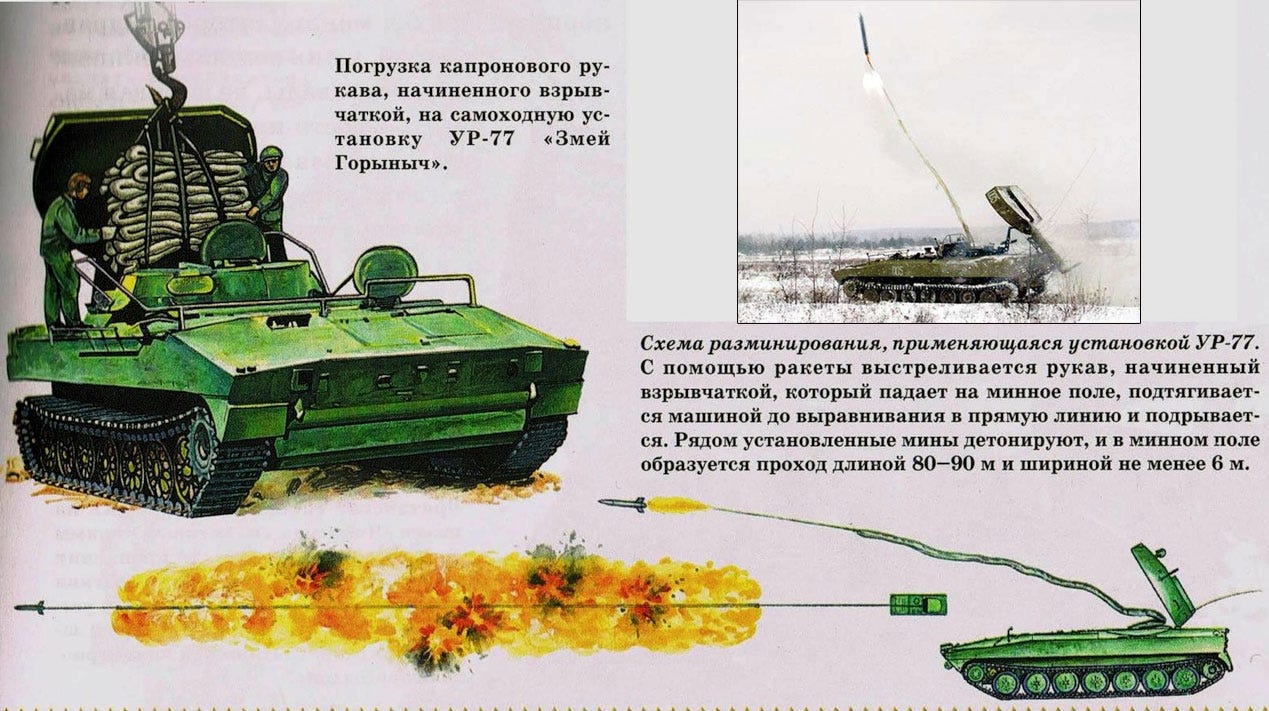Robert Beckhusen
12 Oct 2014
UR-77 Meteorit appears on the front line
Syrian president Bashar Al Assad’s forces have a new tank on the front line—one they haven’t used in the civil war until now. Like most Syrian military hardware, it probably comes from Russia.
It’s the mine-destroying UR-77 Meteorit, recently photographed leaving the heavily-guarded Mezzeh Military Airport after arriving by air, according to a local opposition journalist. It’s destination was the rebel-held, Damascus suburb of Jobar.
The UR-77 is a variant of the 2S1 Gvozdika, a Russian-made tracked artillery piece. But the only real similarity between the UR-77 and the 2S1 is the chassis. Instead of a howitzer, the UR-77 has a turret capable of shooting out a rocket-propelled rope fitted with explosive charges.
It’s an extremely nasty weapon. Known in the U.S. military as a “mick lick,” the line charge is a crude but effective means to clear mines.
Fire the rope down a city street and blow it up, and the expanding pressure wave should destroy most mines planted in the way. It’ll destroy most of the road and buildings as well.
Pro-regime YouTube channels also showed the tank engaged in fighting in Jobar on Oct. 1.
It’s another sign of Russia’s continuing support to the Syrian military. Assad’s military largely uses Russian weapons, and the Syrian air force has long been dependent on Russian-produced spare parts to keep its planes in the air.
The Kremlin’s Main Intelligence Directorate, or GRU, has also provided advisers to help intercept and gather radio signals—which the Free Syrian Army recently discovered after overrunning a spy base near Damascus.
There’s no evidence the Russians have provided training on how to operate the UR-77. But if so, Russian doctrine calls for the vehicle to move with escorts—ground troops and BTR armored vehicles. The escorts’ job is to prevent anti-tank teams from getting close enough to destroy the vehicle before the UR-77 can launch its payload.
But in practice, the vehicle is just as much as a weapon as it is a counter to one, owing to the tremendous blast radius of its explosives at more than 300 feet long and 20 feet wide. The explosion is big enough to blow out a city street and kill anyone in the way.
The Russian army used the UR-77 to lethal effect during the second Chechen war, launching line charges at houses during the fighting for the village of Komsomolskoye. For its part, U.S. Marines heavily used line charges during the 2005 battle for Fallujah.
 “The weight of a charge exceeds one ton and the power of the explosion is such that houses in Komsomolskoye were simply wiped off from the face of the earth,” Moscow Defense Brief observed in a history of Russian weapons used in Chechnya.
“The weight of a charge exceeds one ton and the power of the explosion is such that houses in Komsomolskoye were simply wiped off from the face of the earth,” Moscow Defense Brief observed in a history of Russian weapons used in Chechnya.
The UR-77, illustrated. Art via bayanay.info. At top—a mick lick explosion in Iraq in 2003. Photo via Wikimedia
Booby traps are an excellent weapon for insurgents. To use a convoluted military term, landmines and improvised explosives are force multipliers. This means a few mines—and the fear of mines—has a profound and outsized effect on the behavior of a larger foe.
The Syrian civil war is also characterized by lots of little neighborhood wars. The front lines don’t move around much, because most of the fighting is by people who live in the area and have memorized all the nooks and crannies. Then with everything wired to explode, any push by the Syrian army runs into a spider’s web of things that can explode and kill them.
Al Assad’s troops have to devote a lot of time, resources and troops to painstakingly clearing the booby traps. Mines and improvised explosives also deny the regime of ones of its main strengths in its mobile, armored tank force.
That’s all practical in its own way. But it’s an indiscriminate form of warfare. Mines don’t care who steps on them—and they linger for years after wars more or less end. They continue to maim and kill, and civilians pay a heavy toll.
Syria is also not party to the Ottawa Treaty banning landmines, and the weapon has proliferated throughout the conflict. Though it’s worth noting that the rebels make their own explosive traps, in addition to re-usingcaptured landmines.
But the Syrian army’s new mind-clearing tank can be indiscriminate, too. If Assad’s troops take lessons on how to use it from Russia.
No comments:
Post a Comment